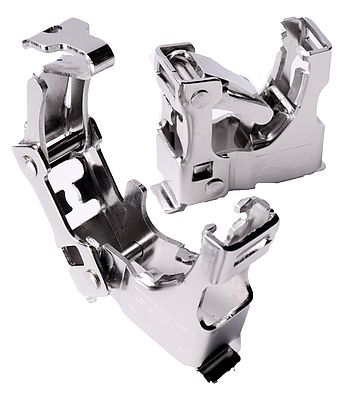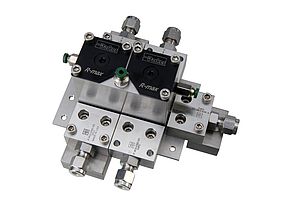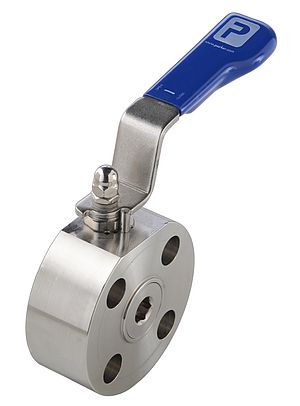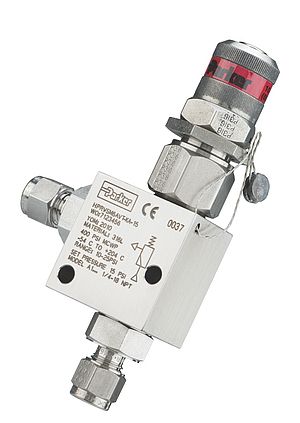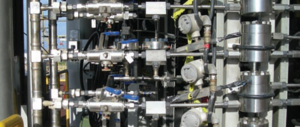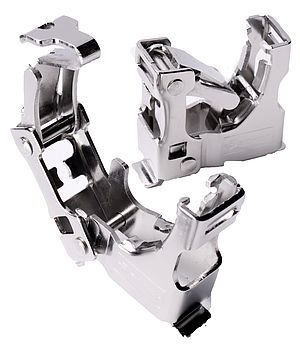A snap-together tubing clamp, constructed almost entirely from 6Mo austenitic stainless steel for enhanced corrosion resistance, has been launched by the Instrumentation Products Division of Parker Hannifin.
The 6Mo tubing clamp - Snap-Trap - raises to the challenges now being faced by energy companies as they strive to recover and process oil and gas from more remote and environmentally hostile areas. In such environments instrumentation can often be exposed to corrosive chemicals such as sulphur, chlorine or salt, and even some standard alloys can corrode quickly in such environments - posing a safety risk.
Based on the same innovative design as the field-proven 316 stainless steel Snap-Trap tubing clamps, but with an even higher resistance to corrosion, the new corrosion resistant alloy model is particularly suitable for applications in high chloride environments such as offshore oil and gas production platforms, and desalination plants. Supplied as a preassembled one-piece unit, the clamp provides a durable means of securing small bore instrumentation tubing; it can be installed quickly and easily, and reused as often as required.
The clamp has unprecedented corrosion resistance, enabling operators to secure instrumentation tubing using a system that provides reliable, long term performance. Its advantages include fast installation, uncompromised integrity and a much-reduced need for routine inspection and maintenance. The clamp fully complies with NORSOK standard Z-CR-101, which demands that tubing clamps should be made of non-corrosive material, must avoid galvanic corrosion between the tubing and its support system, and must not allow water or seawater to accumulate between the clamp and the tubing, which could cause crevice corrosion.
Snap-Trap tubing clamps are one-piece components that can be fitted in seconds. This contrasts with many competing clamps that are multi-piece designs involving assembly of up to 12 separate parts - which can take several minutes. Parker estimates that Snap-Trap can reduce installation time by as much as 40%. Given that the NORSOK standard stipulates that sub-25mm tubing should be clamped every 600mm, and that major installations such as oil platforms can easily demand 10,000+ clamps, simply by switching to Snap-Trap companies can achieve very significant time and cost savings.
For maximum corrosion resistance, Parker's latest Snap-Trap tubing clamps are fabricated almost entirely from 6Mo. Containing at least 6% molybdenum, this super austenitic stainless steel has a much greater resistance to chloride-induced pitting, crevice attack or stress corrosion cracking than standard 300 series or standard duplex stainless steels. Parker has considerable expertise in the design and manufacture of 6Mo valves, tubes and fittings - these products are key drivers behind the industry's adoption of the alloy as a standard for use wherever corrosion has previously proved a problem.
Snap-Trap clamps are compact square components with a U-shaped body and a hinged tube clamp arm. Both the body and the arm feature small tube contact points to minimise opportunities for crevice corrosion, and the entire assembly is free-draining. As the clamp arm closes, it progressively tightens its grip on the tubing, until the end of the arm springs - or 'snaps' - against retaining lugs on the clamp's body, locking it in position. Once closed, the geometry of the clamp ensures that it maintains a very secure hold on the tube. There are no nuts or bolts to tighten, and the flexibility of the clamp arm mechanism enables each Snap-Trap to accommodate two sizes of tube. Four standard sizes of Snap-Trap are available; there are two metric models, one for 6 and 10 mm tubes, the other for 8 and 12mm tubes, plus two imperial models, one for 1/4 and 3/8 inch tubes, the other for 5/16 and 1/2 inch tubes. Larger versions for tubes up to 25mm and 1 inch can be supplied to special order.
Snap-Trap tubing clamps are exceptionally easy to install. The base of the clamp has small protruding feet and a second hinge which allows the feet to be moved together momentarily for clipping into a mounting slot on the tube carrier. As the clamp regains its square shape for gripping the tube, these feet lock onto the carrier; the clamp can be freely repositioned until the clamp arm is closed. This approach allows the clamps to be mounted onto cable and tube trays, field ladders, angle iron, etc, without need of extra components, thereby obviating another potential source of corrosion. Snap-Trap clamps can also be vertically stacked - slots in the body accommodate the mounting feet of another clamp.
A further key benefit of Parker's Snap-Trap design is that the clamps are fully reusable, which means that their labour-saving advantages can multiply over time. The only tool required for installing and uninstalling Snap-Trap tubing clamps is a simple key, which is used to lever the clamp arm into its fully closed position, or to disengage it prior to removing tubing.
Uninstalling a Snap-Trap tubing clamp takes even less time than installation. So, tubing and instrument repairs, refurbishment and repositioning - or other routine maintenance or upgrade tasks - can be accomplished in a fraction of the time it would take with competitive tube clamps.
Snap-action tubing clamp
provides corrosion resistance
- by Parker Hannifin Plc
- October 25, 2012
- 1584 views


